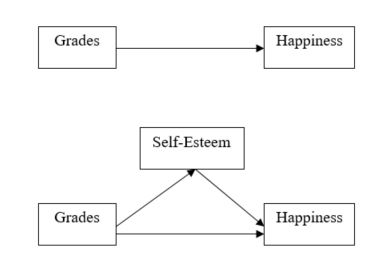Baron and Kenny’s Method for Mediation
A mediator variable is a variable than explains the relationship between a predictor variable and a criterion variable. Mediators tell us how or why something works. The mediator is considered an intervening variable which explains the relationship between a predictor variable and a criterion variable. For the sake of explanation, below is a hypothesized mediation relationship. A simple hypothesis for the first model is that grades in school have a direct relationship on a student’s happiness. By using the mediation model, it is hypothesized that grades in school have a direct relationship on self-esteem, and then self-esteem has a direct relationship on happiness. In other words, we are attempting to establish a chain of influence where grades influence self-esteem, and self-esteem, in turn, influences happiness.

The Baron and Kenny (1986) method is an analysis strategy for testing mediation hypotheses. In this method for mediation, there are two paths to the dependent variable. The independent variable (grades) must predict the dependent variable (happiness), and the independent variable must predict the mediator (self-esteem). Mediation is tested through three regressions:
- Independent variable predicting the dependent variable
- Independent variable predicting the mediator
- Independent variable and mediator predicting the dependent variable
Need help with your analysis?
Schedule a time to meet with an expert using the calendar below.
User-friendly Software
Transform raw data to written, interpreted, APA formatted Mediation results in seconds.
The following conditions must be met in the results to support mediation:
- The independent variable is shown to significantly influence the dependent variable in the first regression equation.
- Independent variable is shown to significantly influence the mediator in the second regression equation.
- Mediator must significantly influence the dependent variable in third equation. Here, the independent variable and mediator are entered as predictors.
Complete mediation is present when the independent variable no longer influences the dependent variable after the mediator has been controlled and all of the above conditions are met. Partial mediation occurs when the independent variable’s influence on the dependent variable is reduced after the mediator is controlled.
References:
Baron, R. M., & Kenny, D. A. (1986). The moderator-mediator variable distinction in social psychological research: Conceptual, strategic, and statistical considerations. Journal of Personality and Social Psychology, 51, 1173-1182.